After the Iraq War, Saddam’s legendary palaces are open to all
After the Iraq war, the closely guarded, lavish estates belonging to the former strongman were opened to the public.
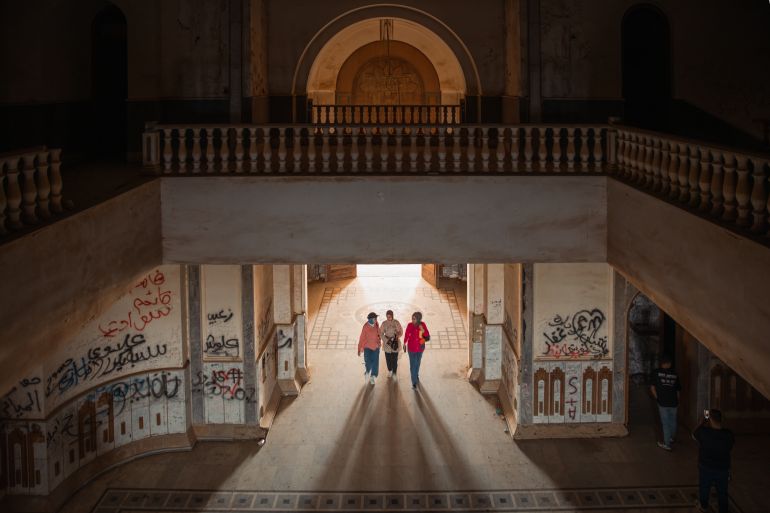
Babylon, Iraq – Mohammed Hakim climbs the marble staircase, looks at the Euphrates River flowing by a veritable oasis of palm trees that stretches as far as the eye can see and snaps a selfie.
“He sure knows how to pick a good spot,” he jokingly said, referring to former Iraqi ruler Saddam Hussein. The expansive building that he is standing in is one of the palaces that belonged to the deposed leader.
Keep reading
list of 3 itemsAbu Ghraib survivor: Taking the hood off 20 years after Iraq war
Photos: Iconic images from the Iraq War
Overlooking the ruins of ancient Babylon, the multistorey palace is a manifestation of the mighty empire that Saddam imagined: spectacular staircases sweep up from a majestic foyer to gigantic rooms that open to a view of the river.
The stately, golden-walled palace is about an hour south of Baghdad, sitting on a man-made hill built on the ruins of the village of Qawarish, which was demolished to free up the strongman’s chosen location.
Recent trouble in the ‘Cradle of Civilisation’
Twenty years ago, before tanks belonging to a United States-led coalition rolled into the capital, Baghdad, and sent Saddam fleeing, stepping on this land was beyond anyone’s wildest imagination.
The notorious leader was toppled on March 20, 2003, when the coalition invaded the country. After he fell, there was a fleeting moment when Iraq dreamed big: The removal of Saddam could maybe bring long-waited peace and prosperity.
Instead, the invasion set off nearly two decades of violence and conflict that plunged the entire nation into chaos and stripped generations of Iraqis of the aspiration to live a normal life.
The palace in Babylon, now reclaimed by the public, has borne witness to the troubled recent history of a country widely known as the “Cradle of Civilisation”.
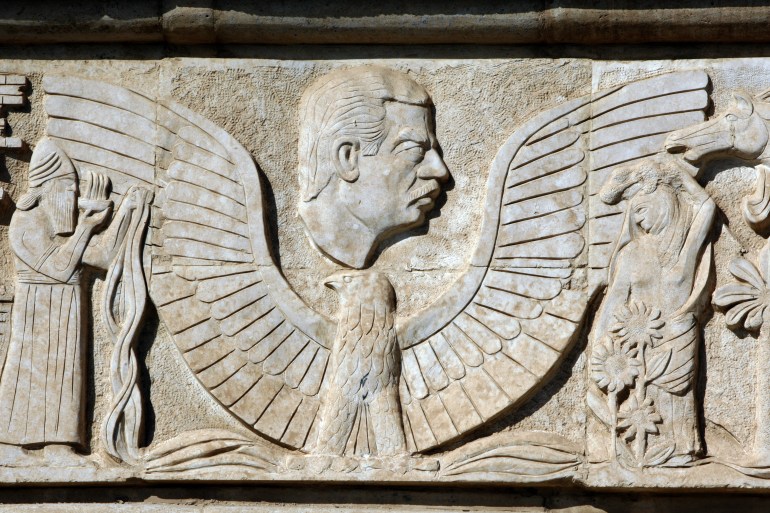
There are traces of Saddam here, like his initials carved on the stone facade and bricks in a back passageway stamped with: ”In the reign of the victorious Saddam Hussein, the president of the Republic, may God keep him, the guardian of the great Iraq and the renovator of its renaissance and the builder of its great civilisation, the rebuilding of the great city of Babylon was done in 1987.”
Apart from that, the palace bears nearly no trace of the former splendour, with its shattered windows, walls covered in graffiti and doves nesting in the beams.
But for Hakim, a 22-year-old college student, entering the previously forbidden premises as an Iraqi citizen is cause for celebration.
“It’s surreal,” Hakim told Al Jazeera, standing among many others who had come to the site to revel in the enchanting view. “You don’t need security or bodyguards to escort you to a place that used to belong to Saddam, and I think that’s amazing.”
Another young man, about the same age, chimed in: “When I enter the palace, I can just imagine that guy [Saddam] sipping his coffee here,” he pointed his finger at the entrance of the grand palace. “He would probably be waving his weapons around, too.”

No one was allowed to make such jokes 20 years ago, and no one was in the mood for jokes following the invasion either, with violence rampant and livelihoods under constant threat.
Now that the large-scale violence has ebbed, Iraq’s younger generation is again dreaming, hoping to build a future that looks beyond the turbulence that shaped their upbringing.
Iraq’s youths are collectively reclaiming the places that either were previously forbidden under Saddam’s rule or were too dangerous in the period of conflict.
In Baghdad’s Adhamiyah district, part of a former palace belonging to Saddam has been transformed into an upscale shopping centre where restaurants with impressive views of the Tigris River host Iraqis late into the night.
By the city’s Jadriyah Bridge, around sunset, youngsters gather in a square with their motorbikes, showing off their drifting skills. Families take their children for picnics to Abu Nuwas Park where entertainment facilities have been built. Young couples stroll along the Tigris, occasionally holding hands.
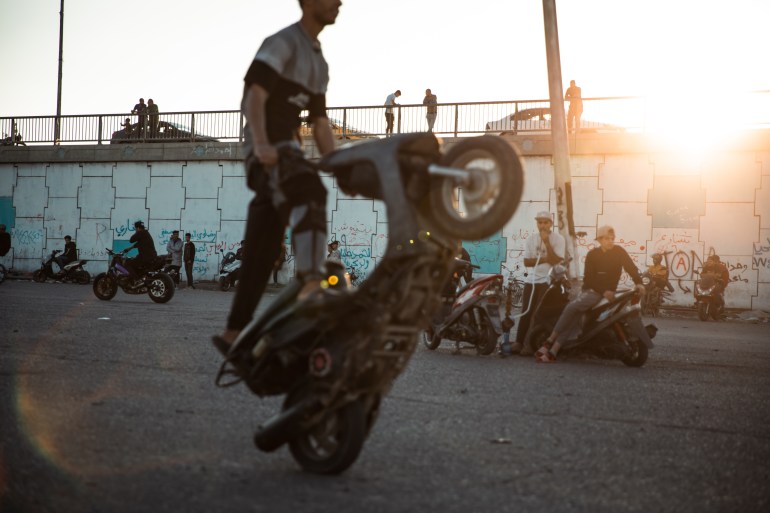
‘We didn’t have a normal childhood’
However, generations of Iraqis have seen only violence and conflict unfolding in their country.
The roaring rocket attacks on Baghdad that marked the beginning of the invasion, the looting that unfolded almost instantly after the fall of Saddam, the subsequent rebellion against the occupation, the sectarian conflict that escalated into a full-blown civil war in 2006, and the continuous violence that gave rise to the ISIL (ISIS) armed group – these defined many Iraqis’ memories of their country.
“We didn’t have a normal childhood because no one should experience even 1 percent of what we experienced,” Zainab al-Shamari, a 21-year-old student at the University of Baghdad, said. She lost her brother in 2006, and her father in 2011.
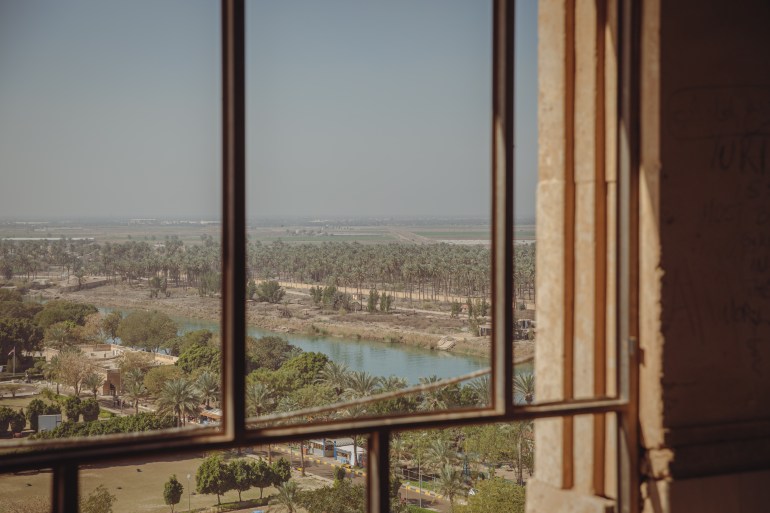
Al-Shamari and her family, who are Shia, used to live in Baghdad’s Dora district, a predominately Sunni neighbourhood. One day in August 2006, at the height of the sectarian conflict, her brother was killed in front of their house and a note was left next to his body: “Leave this neighbourhood or more of you will be killed.”
They suspected al-Qaeda was behind the killing; the armed group used Dora as their “playground”, al-Shamari described. She and her family moved to Basra, Iraq’s second-biggest city.
“My entire childhood was just fear,” she told Al Jazeera while walking on Baghdad’s busy Inner Karada street, three years after returning to Baghdad with her family. “Fear of killing, fear of displacement, fear of this and fear of that.”
Al-Shamari’s story is not uncommon in Iraq. Accurate data on civilian casualties in the past 20 years are hard to come by, but according to the Iraq Body Count project, roughly 200,000 civilians have been killed since the 2003 invasion. Nearly everyone has a story to tell about a lost family member or friend.
The voice of the younger generation
In October 2019, droves of people, mostly young Iraqis, took to the streets as part of the Tishreen movement to demand an overhaul of Iraq’s political system. But members of that movement blame the country’s political elites, often backed by strong militias, for cracking down on the protests and ignoring the demands for change.
“We were hopeful but soon we realised that the militias and political mafias will fight to deaths to keep their interest,” Omar al-Hamadi, a 25-year-old engineer who participated in the 2019 protests, told Al Jazeera on the phone. He left Iraq for Istanbul weeks after militias opened fire on protesters and killed two of his friends in November 2019.
“I will never forgive them, and I don’t think any of my friends will either,” al-Hamadi said.
But even for those who were spared the bloodshed on the streets, corruption and shaky governance in the past years have denied the country’s youth a sustainable future.
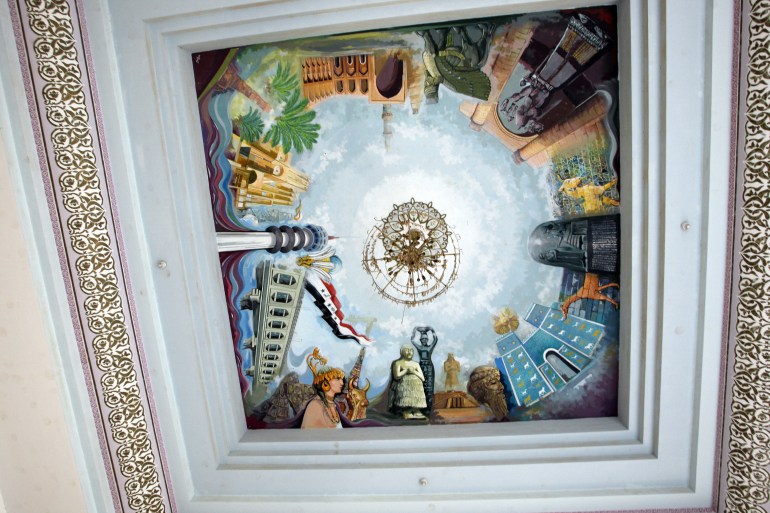
The power-sharing political system based on ethnosectarian division, also known as muhasasa, was established post the 2003 invasion, and it soon led to political infighting that helped brew endemic corruption.
According to former Iraqi Prime Minister Mustafa al-Kadhimi, in the past two decades, more than $600bn has been lost to corruption. The all-pervasive corruption has all but paralysed the young generation’s ability to carve out a future in the country.
“The political elite have consistently failed to anticipate or tackle the long-term socioeconomic and environmental challenges likely to be inherited by today’s youth,” said Hayder al-Shakeri, a research associate at London-based Chatham House’s Middle East and North Africa programme.
For young Iraqis, the price is painfully high. “There is no facility and there is no service in this country because all the money goes to the corrupt officials,” al-Hamadi said.
“Those who have means, like me, are leaving or have already left, and those who cannot leave are continuing to suffer.”
“Even if there are no car bombs any more in Baghdad, the country is killing young people every day.”